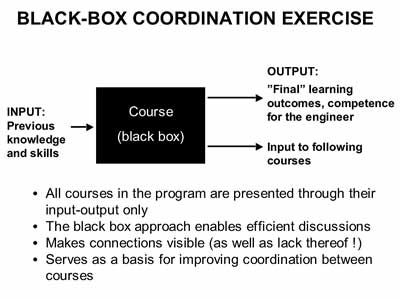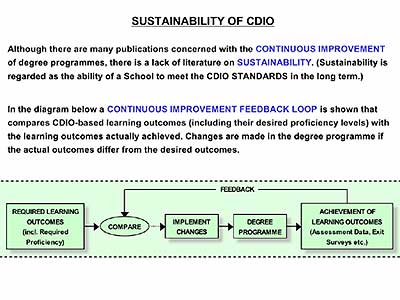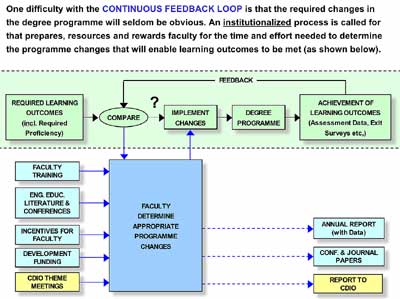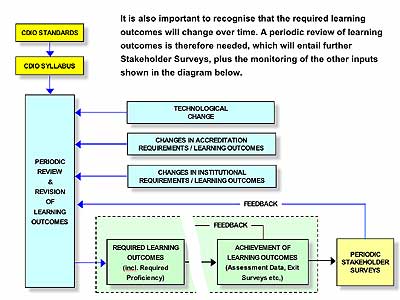Design
There are many approaches, techniques, and activities that may be used to design or revise a curriculum. A slide presentation explaining the design process used by the initial CDIO collaborators may be downloaded here.
Download curriculum presentation (.ppt 196K)
The Black Box Exercise
In this exercise, faculty discuss their courses in terms of input and output knowledge and skills only, in order to collaboratively make explicit the responsibility of each course to the program. Every required course is depicted simply as a black box. For each course, the faculty members state the specific knowledge with which students should enter and leave the course, and bring to future courses. The knowledge and skills are expressed in the form of intended learning outcomes (what students are able to solve/explain/identify etc). It is then possible to identify the connections between courses, and adjust any inconsistencies such as unnecessary redundancy or gaps, where one course has changed without necessary changes being made in other courses, etc.
This exercise enhances dialogue among faculty, and the links between mutually supporting disciplines, and increases awareness of the program as a whole. Experience shows that this exercise sparks productive discussions, and it is therefore wise to allocate ample time to it. It is preferable to do it in one long session, during a retreat if possible. The point of the black box format is to keep discussions as effective as possible. Discussion leaders will want to encourage faculty not to discuss the courses in detail.

Implementation
Intructor Resource Module
We have created a set of Instructor Resources Modules (IRMs) to assist instructors with teaching the CDIO skills in an integrated manner within their existing engineering courses. IRMs are online collections of educational resources that include:
- topic background
- teaching and learning activities
- presentation materials
- problems, exercises and examples
- desired student activity/cognitive process
- best practices from instructors who have integrated these skills into their courses
- general resources (Web sites, books, contacts)
Introductory course
An important part of the CDIO Curriculum is an introductory course. The objective of this course is to introduce students to engineering and to motivate them for engineering studies, as well as support the learning of CDIO skills and provide the first real experiences of engineering work.
The following papers provide information on introductory courses within CDIO programs:
- First-year introductory courses as a means to develop conceive – design – implement – operate skills in engineering education programmes
Download (.doc 116K) - Towards a New Model for First-Year Introductory Courses in Engineering Education Programmes
Download (.doc 120K) - Experiences from the Transformation of an Engineering Education Introductory Project Design Course Into a Project Design-Build-Test Course
Download (.doc 156K)
Sustainability
For any curriculum to remain relevant and viable, it needs to be periodically (perhaps continuously) reviewed. The skills needed by a graduate, as defined by the expectations of industry, faculty, accreditation organizations, and the students themselves, will change with time. Further, the content of classes will also change as instructors come and go. Below is an example program sustainability process that can be tailored to a specific educational program.





